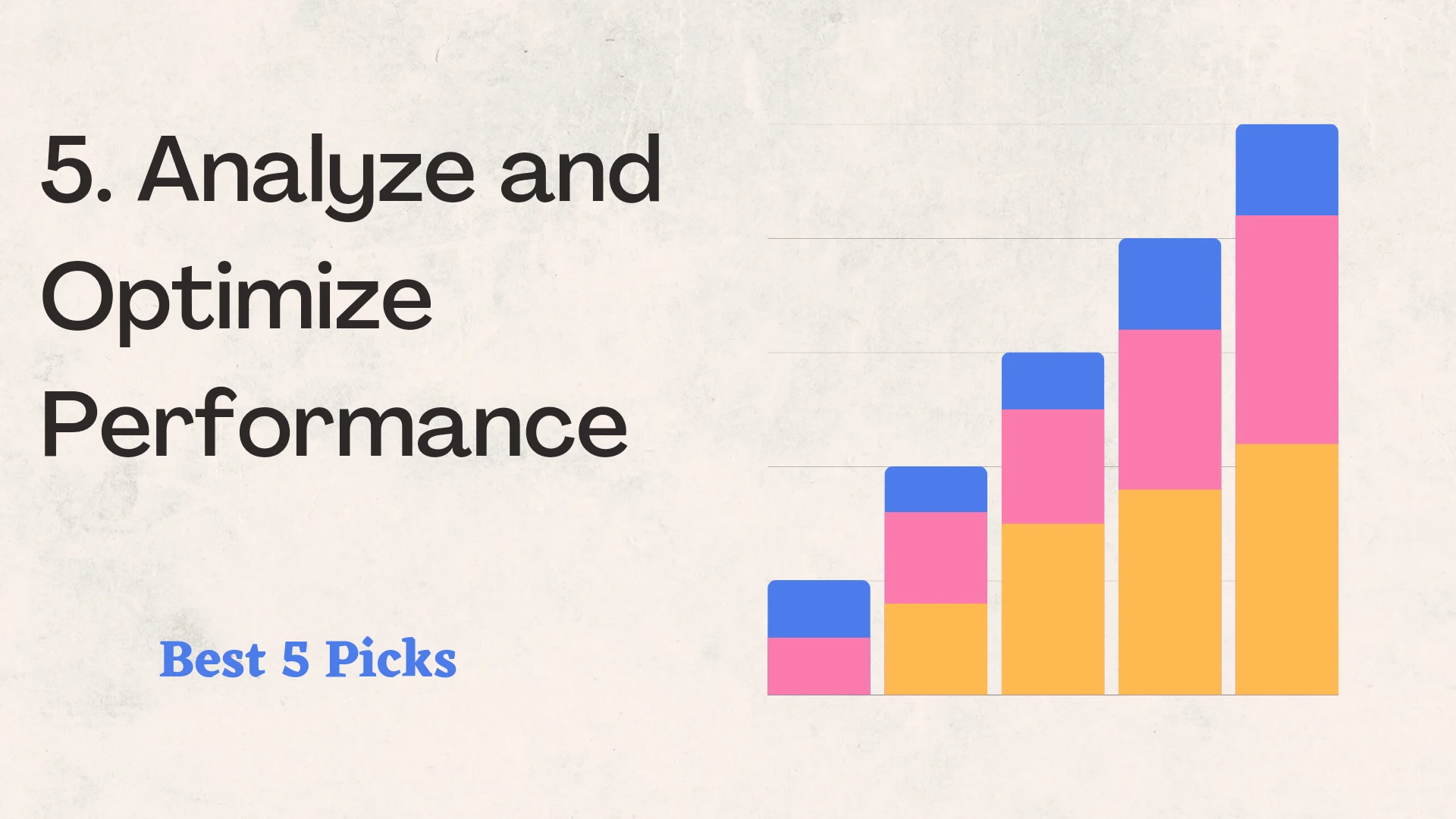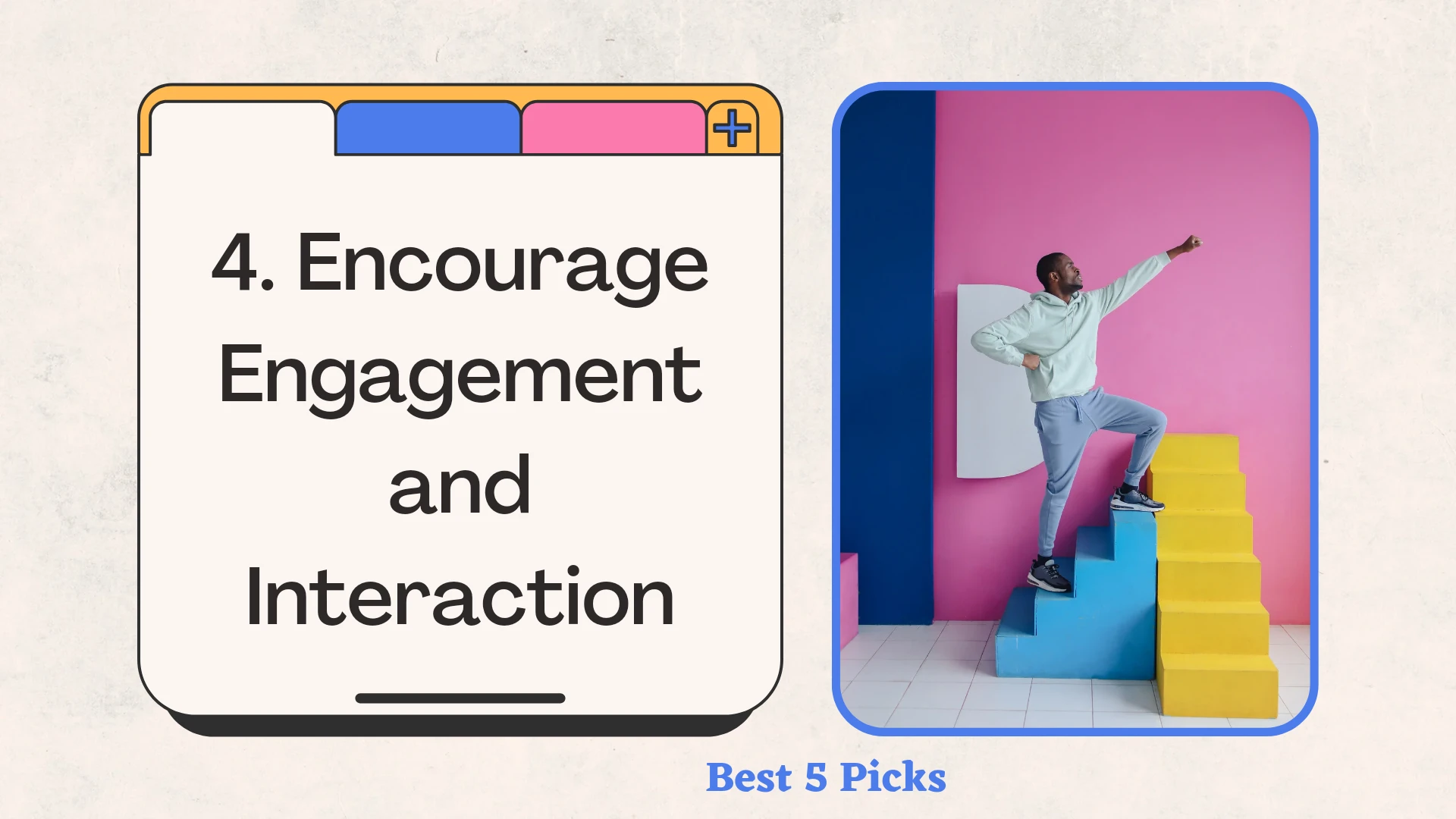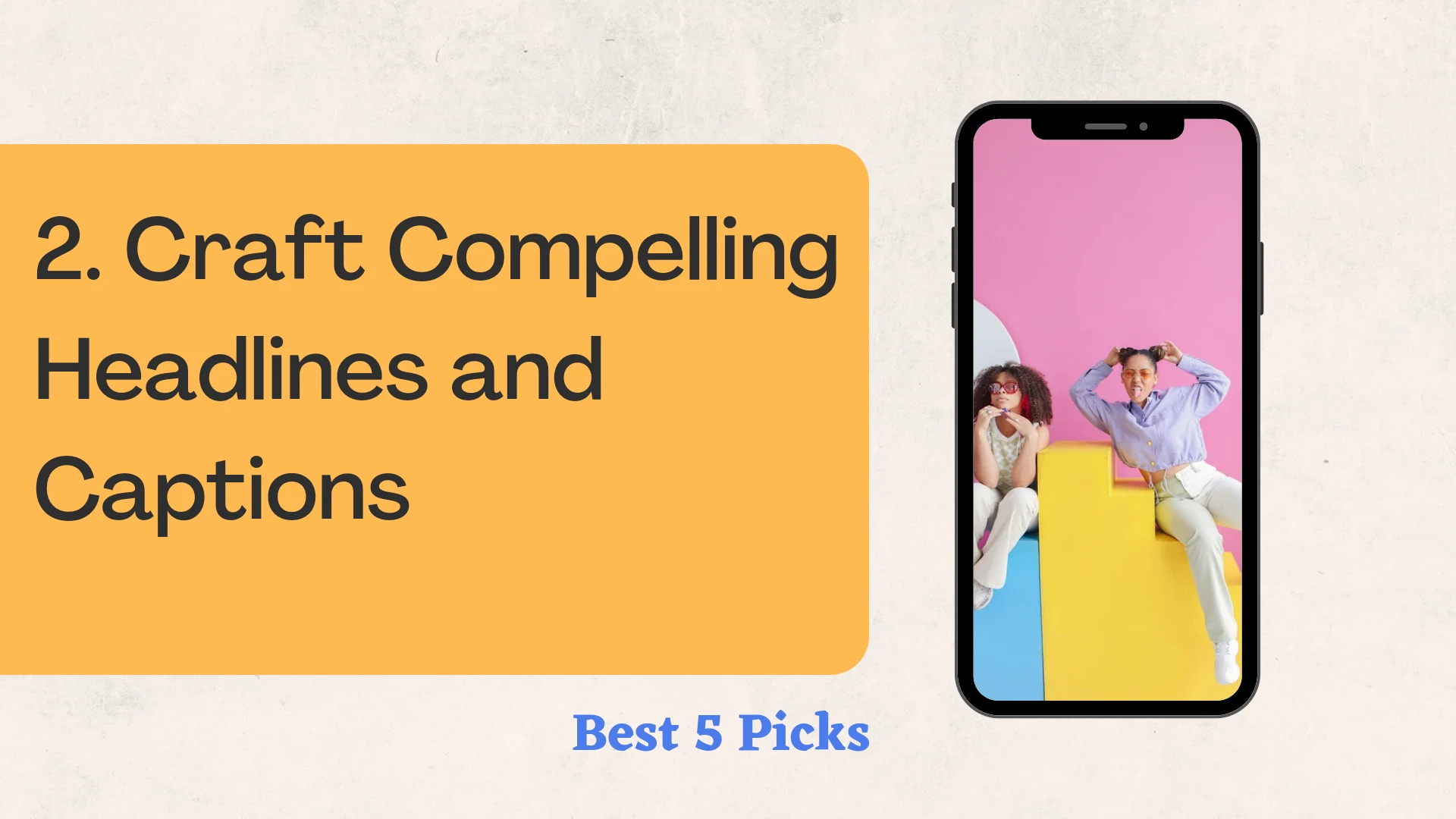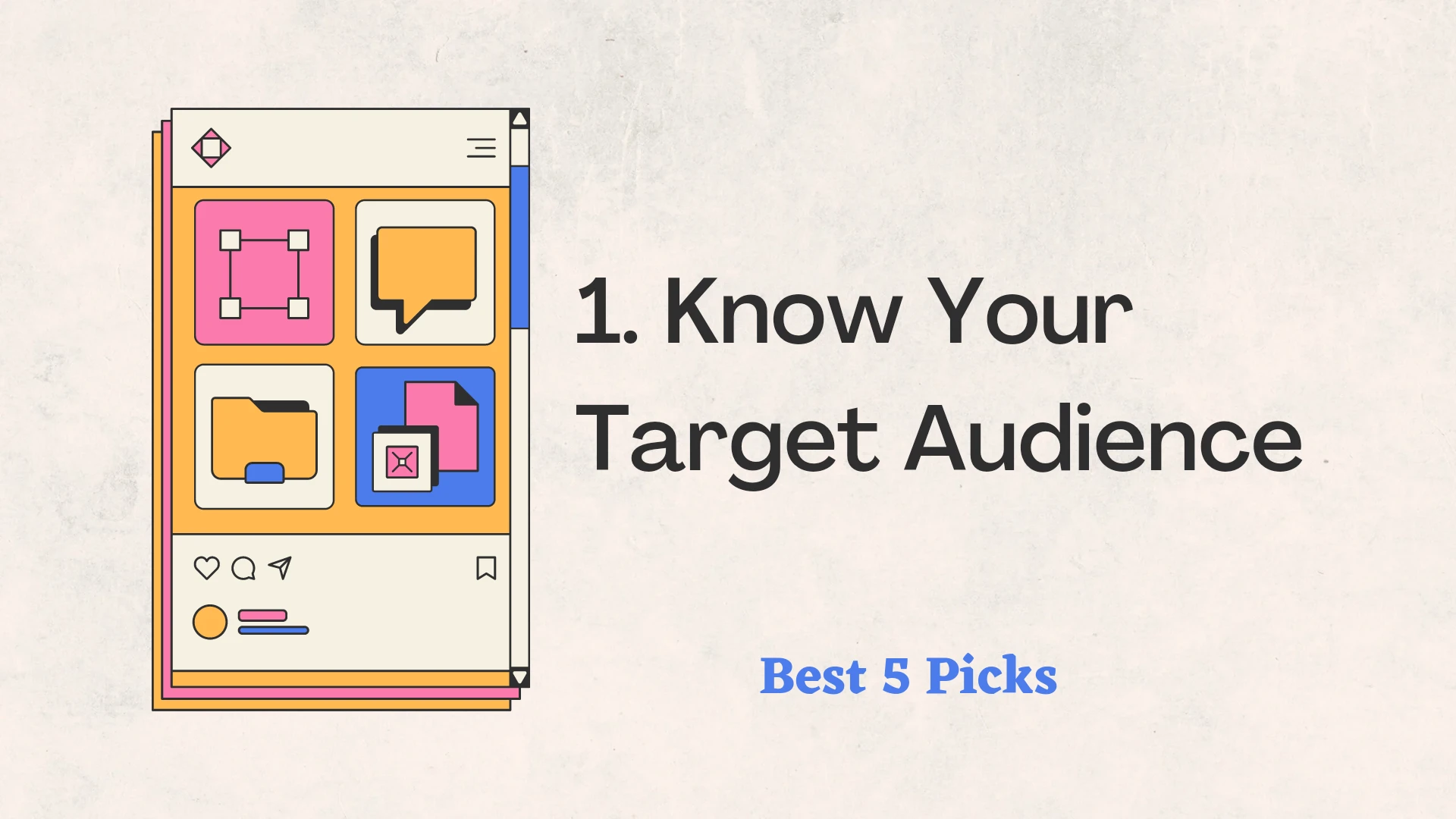Looking to up your social media game? Check out these 5 tips for creating engaging social media content that’ll keep your audience hooked!
From catchy captions to eye-catching visuals, we’ve got you covered.
Whether you’re a seasoned social media pro or just starting out, these tips will help you boost your engagement and connect with your followers like never before.
In today’s digital world, standing out on social media is crucial for success.
With these tips, you’ll learn how to craft content that grabs attention, sparks conversation, and ultimately drives results.
So dive in, get creative, and watch as your social media presence flourishes!
I. Introduction
Unlock the secrets to captivating your audience! Discover 5 game-changing tips for crafting irresistible social media content that keeps them coming back for more. Boost your engagement today!
A. Importance of engaging social media content
Engaging social media content plays a crucial role in today’s digital landscape. With millions of active users across various platforms, it has become essential for businesses, influencers, and individuals to capture and maintain the attention of their target audience.
Engaging content not only helps build brand awareness but also drives user interaction, fosters relationships, and ultimately contributes to the success of social media marketing efforts.
B. Overview of the article’s purpose and structure
This article aims to provide readers with five essential tips for creating engaging social media content. By following these tips, individuals and businesses can enhance their online presence, attract a larger audience, and maximize their impact on social media platforms.
The article will cover key aspects such as understanding the target audience, crafting captivating headlines and captions, utilizing visuals effectively, encouraging interaction, and analyzing performance for optimization.
By implementing these tips, readers will be equipped with the knowledge and strategies to create compelling content that resonates with their followers and achieves their social media goals.
5. Analyze and Optimize Performance

A. Monitor key metrics (likes, shares, comments, etc.)
One crucial aspect of creating engaging social media content is monitoring key performance metrics. These metrics provide valuable insights into how your content is resonating with your audience and can help you make data-driven decisions to optimize your strategy.
Here are some key metrics to monitor:
1. Likes: Likes indicate the number of users who appreciate your content. It reflects the overall positive sentiment towards your posts.
2. Shares: Shares demonstrate the level of engagement and interest your content generates. When users share your content, it expands your reach to their network, potentially attracting new followers.
3. Comments: Comments indicate the level of interaction and conversation surrounding your content. They provide an opportunity for direct engagement with your audience.
4. Click-throughs: Click-throughs measure the number of users who click on links in your posts, leading them to your website or other desired destinations. Tracking click-through rates helps evaluate the effectiveness of your call-to-action.
B. Use social media analytics tools
To efficiently monitor and analyze your social media performance, utilizing analytics tools is essential. These tools provide comprehensive data and insights that can guide your content optimization efforts.
Here are some popular social media analytics tools:
Facebook Insights: For Facebook pages, Insights offers detailed metrics on page performance, audience demographics, engagement, and content reach.
Twitter Analytics: Twitter’s built-in analytics tool provides data on tweet impressions, engagement, followers, and demographics. It also offers insights into the performance of individual tweets.
Instagram Insights: Instagram’s native analytics feature offers valuable information about follower demographics, post reach, engagement rates, and profile interactions.
LinkedIn Analytics: LinkedIn provides analytics for company pages, offering data on follower demographics, engagement, content reach, and visitor insights.
Third-Party Analytics Tools: Several third-party tools, such as Hootsuite, Sprout Social, and Google Analytics, offer advanced analytics capabilities, consolidating data from multiple platforms and providing comprehensive social media performance insights.
By regularly monitoring these metrics and leveraging social media analytics tools, you can gain a deeper understanding of your audience’s preferences, identify high-performing content, and make data-backed decisions to optimize your social media strategy.
C. Identify successful content types and adjust accordingly
Once you have started creating and publishing social media content, it’s crucial to analyze its performance to identify what types of content resonate best with your audience. By recognizing successful content types, you can adjust your strategy to create more of what works and less of what doesn’t.
Here are some key steps to follow:
1. Track Key Metrics: Begin by monitoring key performance indicators (KPIs) such as likes, shares, comments, clicks, reach, and conversion rates. Different social media platforms offer analytics tools or third-party applications that can help you collect and interpret this data effectively.
2. Identify Patterns: Analyze the data to identify patterns or trends in your successful content. Look for commonalities in format, topic, tone, or style. For example, you might discover that your audience responds well to video tutorials, inspirational quotes, or behind-the-scenes glimpses.
3. Audience Feedback: Pay attention to direct feedback from your audience, including comments, messages, or surveys. This can provide valuable insights into what they find engaging or what they would like to see more of in your content.
4. A/B Testing: Experiment with different variations of content types to see which performs better. For example, you can create two versions of a post, each with a different headline or visual element, and track their respective performance to determine which resonates more with your audience.
D. Continuously experiment and iterate based on data
To ensure ongoing success and engagement on social media, it’s essential to adopt a mindset of continuous improvement.
Here are some strategies to help you experiment and iterate based on the data you collect:
Content Variations: Test different content formats, such as images, videos, infographics, or user-generated content. Explore various topics, tones, and approaches to keep your content fresh and interesting.
Posting Schedule: Experiment with different posting times and frequencies. Analyze the engagement levels for each variation and adjust your schedule accordingly. You may find that certain times of the day or week yield higher levels of audience activity.
Collaborations and Influencers: Partner with other brands or influencers to create collaborative content. This can introduce your brand to new audiences and provide a fresh perspective on your content.
Stay Updated on Trends: Regularly research and stay informed about current social media trends, algorithms, and platform updates. By staying ahead of the curve, you can adapt your content strategy to align with evolving user preferences and behaviors.
Feedback and Surveys: Occasionally seek feedback from your audience through surveys or polls. This direct input can provide valuable insights into their preferences and help you refine your content strategy.
Remember, the social media landscape is dynamic, and what works today may not work tomorrow. By constantly analyzing data, experimenting with new ideas, and iterating based on insights, you can ensure your content remains engaging and resonates with your target audience.
4. Encourage Engagement and Interaction

A. Pose thought-provoking questions
One effective way to encourage engagement and interaction on social media is by posing thought-provoking questions. Thought-provoking questions stimulate curiosity and encourage users to share their thoughts and opinions.
Here’s how you can leverage this strategy:
1. Understand your audience: Tailor your questions to align with the interests and preferences of your target audience. Consider their demographics, values, and the topics they are passionate about.
2. Keep questions concise and clear: Craft questions that are easy to understand and answer. Avoid complex or ambiguous queries that may confuse or discourage participation.
3. Be open-ended: Ask open-ended questions that invite users to provide detailed responses rather than simple yes/no answers. This allows for more meaningful discussions and engagement.
4. Trigger emotions: Pose questions that evoke emotions or tap into current trends or relevant topics. Emotional questions are more likely to grab attention and spark conversations.
5. Use visuals: Accompany your questions with compelling visuals to make them more visually appealing and increase the likelihood of user engagement.
B. Run contests, polls, or surveys
Contests, polls, and surveys are interactive methods that not only encourage engagement but also provide valuable insights and feedback from your audience. Here’s how you can effectively implement these strategies:
1. Contests
- Determine your objective: Clearly define the purpose of your contest. Is it to generate user-generated content, increase brand awareness, or reward loyal followers?
- Choose a compelling prize: Offer an attractive prize that aligns with your audience’s interests and motivates them to participate.
- Establish clear rules and guidelines: Clearly communicate the entry requirements, deadlines, and any other relevant information. Ensure that the rules are easy to understand and follow.
- Promote and cross-promote: Use various channels to promote your contest, including social media posts, email newsletters, and website banners. Collaborate with influencers or partner brands to extend your reach.
- Engage with participants: Respond to contest-related comments and messages promptly. Show appreciation for participants’ efforts and maintain a positive and inclusive environment.
2. Polls and surveys
- Define the purpose: Determine the specific information or feedback you seek from your audience. Are you looking for their preferences, opinions, or insights into a particular topic?
- Keep it concise: Keep your polls and surveys short and focused to increase participation. Users are more likely to complete them if they are quick and easy to answer.
- Utilize interactive features: Many social media platforms offer built-in polling features that allow users to vote or choose from multiple options. Take advantage of these features to make the process more engaging.
- Share results and insights: Once you have collected enough responses, share the results and insights with your audience. This not only creates a sense of participation but also demonstrates that you value their input.
By incorporating thought-provoking questions, contests, polls, and surveys into your social media strategy, you can create an interactive and engaging environment that encourages users to actively participate, share their opinions, and build a stronger connection with your brand or content.
C. Respond to comments and messages promptly
One of the key factors in creating engaging social media content is fostering a sense of connection and responsiveness with your audience.
When users take the time to leave comments or send messages, it’s important to acknowledge and respond to them promptly. This not only shows that you value their input but also helps in building a loyal community around your brand or profile.
When responding to comments, aim to be authentic and genuine. Take the time to understand the user’s perspective and provide thoughtful responses. If someone asks a question, provide a detailed answer that addresses their concerns.
If someone leaves a positive comment, express gratitude and acknowledge their support. Similarly, if someone leaves a negative comment or feedback, respond professionally and address their concerns in a respectful manner.
Additionally, encourage further engagement by asking follow-up questions or encouraging users to share their opinions.
This can help spark conversations and keep the engagement going. By actively participating in the comment section, you not only demonstrate your commitment to your audience but also create a sense of community where users feel heard and valued.
D. Foster a sense of community and inclusivity
Creating an inclusive and welcoming environment on social media is crucial for fostering engagement and building a loyal following. People are more likely to engage with content and participate in discussions when they feel included and respected.
Here are some strategies to foster a sense of community and inclusivity:
1. Embrace diversity: Celebrate and highlight diversity in your content. Showcasing people from different backgrounds, cultures, and perspectives helps create an inclusive atmosphere.
2. Encourage participation: Encourage your audience to share their stories, experiences, and opinions. Conduct polls, surveys, or ask open-ended questions to invite contributions.
3. Create a safe space: Establish clear community guidelines and moderate your social media platforms to ensure respectful and constructive conversations. Address any instances of harassment or discrimination promptly.
4. Collaborate with your audience: Involve your audience in content creation by featuring user-generated content, hosting guest takeovers, or running contests that encourage participation. This makes them feel like an integral part of your community.
5. Respond with empathy: Show empathy and understanding in your interactions. Acknowledge and validate the opinions and experiences shared by your audience, even if they differ from your own.
By fostering a sense of community and inclusivity, you create an environment where individuals feel comfortable engaging and contributing to the conversation.
This not only enhances the overall engagement on your social media platforms but also helps in building long-lasting relationships with your audience.
3. Use Visuals Effectively

A. Appeal to the visual nature of social media
In the digital age, social media platforms have become increasingly visual-centric. Users are drawn to captivating visuals that grab their attention and evoke emotions.
To create engaging social media content, it is essential to understand and leverage the visual nature of these platforms.
Here are some strategies to consider:
Storytelling through visuals
Use images and videos to tell a story that resonates with your audience. Visual storytelling helps create a connection, evoke emotions, and make your content memorable. Think about the narrative you want to convey and choose visuals that align with it.
Consistent branding
Maintain a consistent visual identity across your social media presence. Use a cohesive color palette, typography, and design elements that reflect your brand. This consistency helps users recognize and associate your visuals with your brand, reinforcing brand awareness and credibility.
B. Choose high-quality images and videos
The quality of your visuals greatly impacts how users perceive your content and brand. Low-quality or blurry images can create a negative impression and discourage engagement.
Follow these guidelines to ensure your visuals are of high quality:
1. Use high-resolution images: Opt for images that are sharp, clear, and visually appealing. High-resolution images look professional and enhance the overall quality of your content.
2. Invest in professional photography or design: If possible, hire a professional photographer or graphic designer to create custom visuals. They can help you capture your brand’s essence and create unique, eye-catching visuals.
3. Optimize image and video formats: Pay attention to the file format and size of your visuals to ensure fast loading times without sacrificing quality. Compress images without compromising their clarity using tools like Adobe Photoshop or online platforms like TinyPNG.
4. Consider video quality and length: When using videos, prioritize high-definition (HD) or even 4K resolution if appropriate. Additionally, keep your videos concise and engaging, as shorter videos tend to perform better on social media.
By focusing on the visual appeal and quality of your social media content, you can create a more captivating and professional online presence.
These practices help you stand out, capture users’ attention, and leave a positive impression on your audience. Remember to align your visuals with your brand identity and maintain consistency throughout your social media profiles.
C. Incorporate Infographics, Memes, or GIFs
Visual content is highly effective in capturing and retaining the attention of social media users. In addition to high-quality images and videos, incorporating infographics, memes, or GIFs can further enhance the engagement levels of your social media posts.
Here’s why and how you should use these visual elements:
Infographics are visually appealing and informative representations of data, statistics, or processes. They condense complex information into easily digestible visuals, making them highly shareable and engaging.
Consider creating infographics relevant to your industry or niche, presenting interesting facts or tips, or summarizing research findings. Tools like Canva, Piktochart, or Adobe Illustrator can help you design professional-looking infographics even if you have limited design skills.
Memes are humorous or relatable images or videos that spread rapidly across social media platforms. They have become a popular form of visual communication and can effectively engage your audience. However, it’s crucial to use memes appropriately and align them with your brand image and target audience.
Incorporate trending or industry-specific memes that resonate with your followers’ interests and sense of humor. Create original memes or share existing ones, but always give credit to the original creator if applicable.
GIFs (Graphics Interchange Format) are short, looping animations that add an element of motion and entertainment to your social media content. They are versatile and can convey emotions, reactions, or actions effectively.
GIFs can be sourced from online databases like GIPHY or created using tools like GIPHY Capture or Photoshop. Use GIFs to emphasize a point, express excitement, or inject humor into your posts.
D. Maintain Consistency in Branding and Aesthetics
Consistency in branding and aesthetics is crucial for building brand recognition and creating a cohesive social media presence.
When it comes to visuals, it’s important to maintain a consistent style, color palette, and overall aesthetic that aligns with your brand identity.
Here are some key considerations:
1. Color Palette: Choose a color palette that reflects your brand personality and values. Use these colors consistently across your visuals to create a recognizable and cohesive look. Consider the psychological impact of colors and select hues that evoke the desired emotions or associations.
2. Fonts and Typography: Select a set of fonts that align with your brand’s tone and style. Use these fonts consistently in your visual content, ensuring readability and visual harmony. Consider using a combination of fonts for headlines, captions, and body text to add variety and hierarchy.
3. Logo and Branding Elements: Incorporate your logo and other branding elements such as taglines, slogans, or watermarks into your visual content. Ensure they are appropriately sized and positioned for visibility without overpowering the main message.
4. Visual Style: Develop a consistent visual style that reflects your brand’s identity. This can include factors such as minimalistic, bold and vibrant, vintage, or sleek and modern. Consistency in visual style helps your audience recognize and connect with your content.
By incorporating infographics, memes, or GIFs into your social media strategy and maintaining consistency in branding and aesthetics, you can create visually engaging content that stands out, attracts attention, and strengthens your brand identity.
Remember to keep the visuals relevant, aligned with your target audience’s preferences, and optimized for each social media platform’s specifications.
2. Craft Compelling Headlines and Captions

A. Importance of attention-grabbing headlines and captions
Attention-grabbing headlines and captions are vital components of engaging social media content. In today’s fast-paced online environment, users have limited time and countless options to choose from. Therefore, it is crucial to make a strong first impression and capture their attention within seconds.
Here’s why attention-grabbing headlines and captions are important:
1. Increased Visibility: Compelling headlines and captions increase the likelihood of users stopping their scrolling and clicking on your content. This can result in higher visibility, increased reach, and potential new followers or customers.
2. Improved Engagement: When your headlines and captions are intriguing and captivating, users are more likely to engage with your content. They may like, comment, share, or click through to learn more, thereby increasing the overall engagement metrics of your posts.
3. Enhanced Brand Perception: Strong headlines and captions reflect positively on your brand. They convey professionalism, creativity, and a clear understanding of your audience’s interests. This helps build trust and credibility with your followers.
B. Use concise and impactful language
To create compelling headlines and captions, it is essential to use concise and impactful language.
Here are some tips for crafting powerful and concise content:
Be Clear and Concise: Use concise language to convey your message efficiently. Eliminate unnecessary words and focus on the core message to ensure your headline or caption is easily digestible.
Highlight the Value: Communicate the value or benefit that users will gain from engaging with your content. Whether it’s entertainment, knowledge, or a solution to their problems, make it clear and enticing.
Use Strong Verbs and Adjectives: Incorporate strong action verbs and descriptive adjectives to make your headlines and captions more vibrant and engaging. These words evoke emotions and create a sense of urgency or curiosity.
Spark Curiosity: Pose thought-provoking questions, tease intriguing information, or create a sense of mystery to pique the curiosity of your audience. This can entice them to click through and explore further.
Test Different Formats: Experiment with different headline or caption formats to see what resonates best with your audience. This could include using lists, how-to guides, statistics, quotes, or emotional appeals.
Remember, in the context of social media, brevity is key. Capture attention with a strong headline or caption, and then let the rest of your content deliver on the promise you’ve made.
By using concise and impactful language, you’ll be able to create compelling headlines and captions that drive engagement and encourage users to interact with your social media content.
C. Incorporate relevant keywords and hashtags
When crafting headlines and captions for your social media posts, incorporating relevant keywords and hashtags can significantly boost their visibility and discoverability.
Here are some key points to consider:
1. Research relevant keywords: Conduct keyword research to identify the terms and phrases commonly used by your target audience.
Tools like Google Keyword Planner or social media analytics platforms can help you find popular keywords related to your industry or topic. Incorporating these keywords naturally into your headlines and captions can help your content appear in relevant search results.
2. Use popular hashtags: Hashtags are powerful tools for increasing the reach of your social media posts. Research and identify popular hashtags that are relevant to your content and industry.
Consider using a mix of broader hashtags with high search volumes and more specific niche hashtags. This strategy allows you to reach a broader audience while targeting specific communities or interests.
3. Keep it concise: With limited character counts on platforms like Twitter/X or Instagram, it’s crucial to keep your headlines and captions concise.
Use impactful and attention-grabbing language while ensuring clarity and relevance. Aim to convey the key message or value proposition of your content in a succinct and compelling manner.
D. Experiment with different formats (questions, lists, etc.)
To keep your social media content fresh and engaging, it’s essential to experiment with different formats.
Here are a few formats you can try:
- Questions
Pose thought-provoking questions that encourage your audience to engage and share their opinions. This format sparks discussions and creates opportunities for meaningful interactions. Ensure the questions are relevant to your content and aligned with your target audience’s interests.
- Lists
Create content in a list format, such as “Top 10 Tips,” “5 Must-Have Tools,” or “7 Strategies for Success.” Lists are easy to read, visually appealing, and offer quick and actionable insights. They also tend to perform well and generate engagement.
- Quotes
Share inspiring or relatable quotes that resonate with your audience. Visual quotes overlaid on eye-catching images can capture attention and be easily shared. Ensure the quotes align with your brand’s values and messaging.
- Behind-the-scenes glimpses
Take your audience behind the scenes by sharing exclusive content, sneak peeks, or glimpses into your creative process. This format adds a personal touch, builds authenticity, and helps foster a sense of connection with your audience.
Remember, not every format will work equally well for every audience or platform. Experiment with different formats, analyze the performance of each type of content, and adapt your strategy based on the engagement and feedback you receive from your audience.
1. Know Your Target Audience

A. Conduct audience research
Before creating engaging social media content, it is crucial to conduct thorough audience research. This step allows you to gain a deep understanding of your target audience, their characteristics, behaviors, and preferences.
Here are some key points to consider:
1. Define your target audience: Start by clearly defining who your target audience is. Consider factors such as age, gender, location, profession, interests, and lifestyle. The more specific and well-defined your audience persona is, the better you can tailor your content to their needs.
2. Analyze demographics: Use analytics tools provided by social media platforms to gather data on your existing audience. Look at metrics such as age, gender, location, and language to identify patterns and trends.
3. Utilize market research: Conduct surveys, interviews, or focus groups to gather insights directly from your target audience. Ask questions about their preferences, interests, and challenges related to your industry or niche. This qualitative data can provide valuable insights into their motivations and desires.
B. Identify demographics, interests, and preferences
1. Demographics: Identify the key demographics of your target audience, such as age, gender, occupation, income level, and education. This information helps you understand their characteristics and tailor your content accordingly.
2. Interests and hobbies: Determine the interests, hobbies, and activities that resonate with your target audience. Consider their favorite books, movies, sports, or other recreational activities. This knowledge enables you to create content that aligns with their passions and engages their attention.
3. Online behavior: Study your target audience’s online behavior. Identify the social media platforms they frequent the most and understand their preferred content formats (e.g., articles, videos, images). This information helps you optimize your content strategy and choose the right platforms for maximum reach.
4. Pain points and aspirations: Dive deeper into the pain points, challenges, and aspirations of your target audience. What are the problems they face, and how can your content address those issues? Tailoring your content to provide solutions or inspiration can greatly enhance engagement.
By conducting thorough audience research and understanding their demographics, interests, and preferences, you can create content that resonates with your target audience on a deeper level.
This knowledge enables you to develop more targeted and relevant content, resulting in increased engagement, shares, and conversions on social media platforms.
C. Tailor content to resonate with your target audience
To create engaging social media content, it is crucial to understand your target audience and tailor your content specifically to their preferences, interests, and needs.
Here are some strategies to help you resonate with your audience:
1. Conduct thorough audience research: Start by gathering information about your target audience. Identify their demographics, such as age, gender, location, and occupation. Dive deeper into their interests, hobbies, values, and pain points. This research will help you gain insights into their motivations and preferences.
2. Create audience personas: Develop fictional characters that represent your different audience segments. Give them names, ages, occupations, and detailed descriptions. This exercise will help you visualize and understand your audience better, enabling you to create content that appeals to them individually.
3. Speak their language: Use the tone, language, and style that your audience can relate to. If your target audience is millennials, for example, consider using a conversational and informal tone. Be aware of the slang, buzzwords, and cultural references that resonate with them. Aligning your content with their language will make it more relatable and engaging.
4. Address their pain points: Identify the challenges or problems your audience faces and create content that provides solutions. Whether it’s educational tutorials, practical tips, or inspiring stories, addressing their pain points will establish you as a valuable resource and keep them engaged.
5. Personalize your content: Leverage data and analytics to personalize your social media content. Segment your audience based on their interests, purchase history, or engagement patterns, and deliver tailored content to each segment. Personalization creates a sense of exclusivity and relevance, making your audience more likely to engage with and share your content.
6. Stay current and relevant: Keep up with the latest trends, news, and conversations within your industry and your audience’s interests. Incorporate these elements into your content to stay relevant and demonstrate that you are in tune with your audience’s needs and preferences.
7. Test and iterate: Continuously monitor your audience’s response to your content. Pay attention to engagement metrics such as likes, shares, comments, and click-through rates. Experiment with different content formats, topics, and approaches to see what resonates the most with your audience. Use the insights gained to refine and optimize your content strategy over time.
By tailoring your content to resonate with your target audience, you can create a strong connection and foster engagement on social media platforms.
Understanding their needs, preferences, and motivations will guide you in producing content that captivates their attention, builds trust, and encourages ongoing interaction.
II. Conclusion
In this article, we have explored 5 Tips for Creating Engaging Social Media Content.
A. Emphasize the importance of ongoing adaptation and improvement
Creating engaging social media content is not a one-time task but an ongoing process. The digital landscape and audience preferences are ever-evolving, and it is crucial to adapt and improve your content continually.
Keep up with the latest trends, gather feedback from your audience, and be open to experimentation. By staying proactive and adaptable, you can maintain a competitive edge and consistently deliver content that captivates and delights your followers.
B. Encourage readers to implement the tips for creating engaging social media content
Now that you have gained valuable insights into creating engaging social media content, it’s time to put these tips into action. Take a moment to evaluate your current social media strategy and identify areas for improvement.
Implement the tips shared in this article and tailor them to suit your unique brand and target audience. With dedication, consistency, and creativity, you can create compelling content that resonates with your followers, fosters meaningful interactions, and drives the success of your social media presence.
III. Quick Recap of 5 Tips for Creating Engaging Social Media Content
- Know Your Target Audience
- Craft Compelling Headlines and Captions
- Use Visuals Effectively
- Encourage Engagement and Interaction
- Analyze and Optimize Performance
In conclusion, creating engaging social media content is vital for online success. By understanding your audience, crafting compelling headlines, using visuals effectively, encouraging interaction, and analyzing performance, you can optimize your content for maximum impact. Start implementing these tips today to elevate your social media presence and achieve your goals.
Remember, building engagement on social media takes time and effort, but the rewards are worth it. So, go ahead and start implementing these tips to take your social media presence to the next level. Good luck!
IV. Frequently Asked Questions (FAQ)
Why is knowing your target audience important?
Understanding your target audience helps tailor your content to their interests, preferences, and needs. This increases the chances of engagement and resonance with your audience, leading to better results for your social media efforts.
How can I craft compelling headlines and captions?
Craft headlines and captions that are attention-grabbing, concise, and relevant to your audience. Use language that evokes emotions or curiosity, and highlight the value or benefit of engaging with your content.
What are some effective ways to use visuals on social media?
Visuals play a crucial role in capturing attention on social media. Use high-quality images, videos, infographics, and other visual content that align with your brand and message. Incorporate visually appealing elements to enhance the storytelling aspect of your posts.
How can I encourage engagement and interaction with my audience?
Encourage engagement by asking questions, inviting opinions, running polls, hosting contests, and responding promptly to comments and messages. Create a sense of community by fostering discussions and acknowledging your audience’s contributions.
Why is it important to analyze and optimize content performance?
Analyzing content performance provides valuable insights into what resonates with your audience and what doesn’t. Use analytics tools to track metrics such as reach, engagement, click-through rates, and conversions. Optimize your content strategy based on these insights to improve results over time.
Can I use the same content strategy for different social media platforms?
While some overarching principles apply across platforms, it’s essential to tailor your content strategy to each platform’s unique characteristics and audience demographics. Consider the format, tone, and preferences of each platform to maximize engagement.
How often should I post on social media to keep my audience engaged?
The frequency of posting depends on your audience’s preferences, the platform you’re using, and the type of content you’re sharing. Consistency is key, but avoid overwhelming your audience with too many posts. Test different posting frequencies and monitor engagement metrics to find the right balance.
What role does storytelling play in social media content?
Storytelling humanizes your brand and creates an emotional connection with your audience. Use storytelling techniques to convey your brand’s values, share customer testimonials, or narrate behind-the-scenes stories. Authentic and compelling narratives can captivate your audience and encourage engagement.
How can I stay updated with the latest social media trends and best practices?
Stay informed by following industry experts, attending webinars and conferences, and actively participating in online communities related to social media marketing. Regularly review case studies and keep an eye on emerging trends and platform updates to refine your strategy accordingly.
What should I do if my social media content isn’t getting the desired engagement?
If your content isn’t performing as expected, experiment with different formats, topics, and posting times. Solicit feedback from your audience and analyze competitor strategies for inspiration. Continuously refine your content based on insights and feedback to improve engagement over time.










